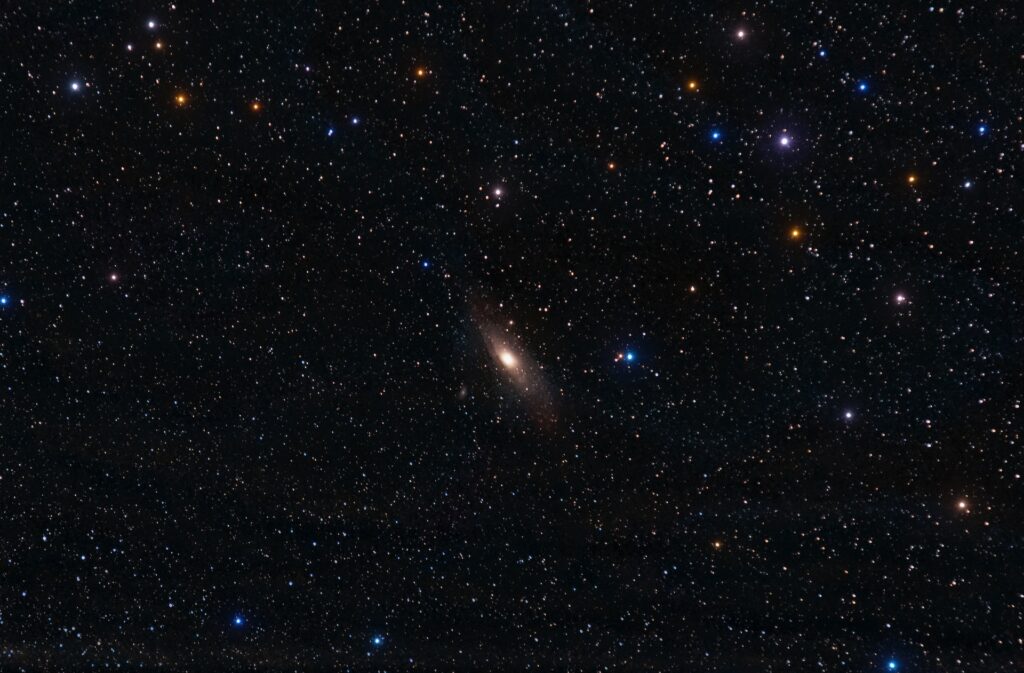Abstract
Black holes start their lives as big dead stars in the depth of the universe. As they move towards the outer universe they gather cosmic dust, asteroids, planets, eventually they get bigger. The gravitational force increases and continues this process for billions of years. When an asteroid enters the gravitational field of an ever-growing dead star, it is pulled in and gets smashed against the core’s surface, into fundamental particles. The gravitational pull has grown to such an extent, the protons and neutrons get packed into the core so tightly that electrons cannot penetrate the core’s surface to form atoms with the firmly embedded protons and neutrons of the core. All the stars in a galaxy have rotation and revolution. How do they get it? Galaxies are rather flat. Why? This research aims to understand facts of this theory on the evolution of the barred spiral galaxies. As the cores of the black sphere blast out the stars, huge quantity of atomic dust and gas are also released. These dust and gas clouds speed along with the stars, enter, and illuminate the Arms. The open end of the Arm presents its open end and gives these orbiting dust clouds and the stars a passageway into the space. The dust clouds and the stars enter the space and create the Spiral Arms. These atomic dust and gas particles reflect and scatter the light rays from the nearby stars.
1. THE SECRETS OF BARRED SPIRAL GALAXIES
BLACK HOLES
What goes in should ultimately come out. Every black hole has consumed billions and billions of heavenly bodies. Hence, each and every black hole has enough material to form a galaxy of stars. In appropriate conditions it will spit out the maker that it once consumed. I take up this philosophy of star birth and want to explain the process step by step.
Though a black hole has enough material, it cannot by itself give birth to a star. A black hole could only consume. To release a star it needs outside help. Fundamentally we can assume a black hole has—
- A core.
- A vacuum sphere around the core. Even a ray of light cannot escape from this sphere—that is why the sphere is black—a black hole.
- And negative charges surround the black sphere.
For a change let us take up the case of earth and moon. Moon revolves around the earth. During its revolution, when the orbiting moon comes near the earth, it carats the ocean and sea and causes high tides. Suppose the moon approaches the earth further, the tidal rise will be much higher. If the moon gets nearer and nearer the earth, following things will happen.
- At first the tidal waves will rise to great heights.
- Then there will be outrageous storms.
- Mountains will be uprooted and will take off the ground.
- If the velocity of the flying mountains is sufficient then they will launch themselves into the space.
If such things could happen to the earth, what will be the outcome if the most powerful giants of the universe meet? The powerful giants are the black holes of the uni-verse. The meeting of the two giant black holes will trigger the birth of a galaxy.
Among the existing trillions and trillions of black holes, there are billions of chances for any two black holes to approach each other and hence there are chances of formation of billions of galaxies. We may now follow the interesting developments of such a black hole meeting another black hole.
In figure 1, two black holes are nearing each other.
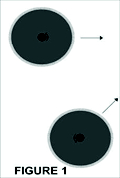
Let us again go to our moon and earth story. Earth pulls the moon and the moon pulls the earth. There then develops a no gravitational area (gravitation free area) in the space in between the earth and the moon. In this specific area, the gravitational force of the earth and the force of gravitation of the moon are equal and cancel each other. This area is free from the pulls of the earth and the moon. However, due to the overall effect of the gravitational forces of the sun and other planets around the moon and earth, the gravitation free area, in between the moon and earth, is not perfectly formed.
As is in between the moon and the earth, there develops a (perfect) no gravitational area in between core A and core B of the two black hole cores that have come under one huge black sphere.

We are now to witness the initiation of the nature at its most beautiful form. In this universe every heavenly body however big or small it may be, has two move-ments – rotation and revolution. Core A and core B also have these movements. The cores A and B rotate, and they also revolve around each other. These two movements initiate the birth and growth of a galaxy.
Let us consider the Figure 5
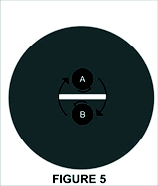
Within the dark sphere there are two cores of the two black holes. These cores rotate and revolve. In between the cores A and B, there develops a bar of no gravity area. The bar is an area where the gravitational pull of core A is equaled or rather cancelled by the gravitational pull of core B. It is a gravity free area.
When core A and core B revolve around each other, the Bar in between them also rotates. When the cores make one complete revolution around each other, the Bar also makes one complete rotation as shown in Fig 6.
The length of the Bar is proportional to the diameter of the circular orbital path of the revolving core A and the core B.
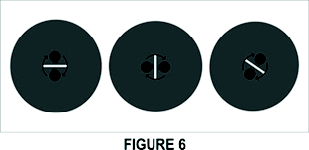
Does the no gravity area end at the Bar level itself? It is not so. The no gravity area extends beyond both ends of the Bar and reaches to the outermost part of the black sphere. We call these extensions as Arms. These Arms grow broader at their end due to the decrease of the gravitational pull power of the cores A and B with the distance. The Arms are broadest as they reach the outer circumference of the black sphere. And also due to the absence of any gravitational pull at the Bar and Arms, a ray of light emerging from that area, could reach up into space. The light will also brighten the Bar and Arms.
Except for the Bar and Arms, the remaining parts of the black sphere are under the tremendous gravitational pull of the cores A and B. No light can escape from these parts and therefore these parts of the sphere are always dark and black.
Consider the figure 7. The Bar and Arms are straight
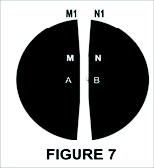
Now consider the figure 8
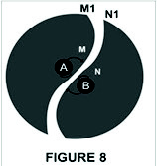
As the cores A and B revolve, the Bar in between them rotates. It should be noted that M1 and N1 are so many light years away from M and N respectively. As the stretch MN begins to move along with the bar, the impact of the movement of MN will be felt at M1N1aker millions of years only. This means, the full length of MM1 and NN1 will get stretched, as the stretch MN starts to move along with the Bar and M1N1 remains stationary for millions of years. The movement of MN and the stretching of MM1 and NN1 will be going on and on, until M1N1 also begins to move. This movement of M1N1 is going on and on, and secles at a speed at which the time taken by the stretch M1N1 to make one complete circle is exactly the time taken by the stretch MN for completing one full circle. At this stage the Arm secles to a constant length and slope. Though this explanation is satisfactory and serves the purpose, the same may be explained in another way also.
Consider the northern hemisphere of the black sphere. Actually, as core A advances in its orbital path, its enormous gravitational force is also moved forward along the complete length of the lek border of the straight Arm of this hemisphere. Gravitational force felt at any part of the lek side length of this Arm is proportional to its nearness to core A. That is, the gravitational pull exerted at the lowest part of the said Arm (the point of Arm joining the Bar) will be much greater and earlier than as at that part of the open-ended Arm which is further most from core A. That is, due to movement of core A on its orbital path, the consumption of light rays at the lower border of the lek side of this Arm is much earlier than at the open-ended straight Arm. In other words, the forward movement of the darkness at the lek border of the lowest part of this Arm is earlier than at the open-ended Arm. And due to the continuous forward movement of core A and subsequent forward movement of the darkness in the lower part of the Arm, the whole lek side of the said straight Arm, in due time, gets stretched and bent. That is, the lek side border of the straight No Gravity Area gets a sloping and bending.
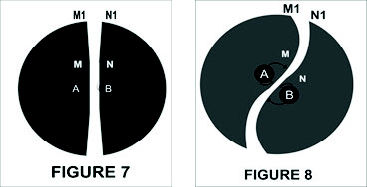
In the meantime, the core B is also moving in its orbital path in the southern hemisphere and its gravitational force is also withdrawing (freeing the light rays to escape into the space) from the right-side border of the Arm of the northern hemisphere. Here also the rate of release of light rays, that is, the withdrawal of the darkness is earlier, at the points of nearness of the right-side border of the northern Arm to core B. That is, the withdrawal of the darkness is much earlier in the lower part of the right side of the Arm (of the northern hemisphere) than at that open end of the Arm. Thus, due to continuous advancement of the core A and comparative withdrawal of the core B, the visual bending of the lek side and right side of the Arm goes on and on, until M1N1 also makes visual moving and the time taken for making one complete revolution, by the open-ended Arm, the breadth of any part of the Arm and the Bar are the same. At this stage, the Arm secles to a constant slope and bending. For-mation of this gravitation free curving Arms are the SPACE HIGHWAYS laid for the nascent stars to pass from the black sphere into the space. These are PATHS OF LEAST RESISTANCE available for use by the stars in the black sphere. See figure 9. The complete system of the black sphere together with its cores, the Bar and the Arms functions as the axis of a galaxy.
THIS IS THE AXIS THAT ROTATES A GALAXY.
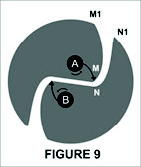
2. BIRTH OF STARS
The core A and the core B exhibit the most tremendous gravitational forces of the universe. If the cores come close enough, then they will pull and pluck each other.
Greatest pulling force is exhibited at the cores’ equatorial surfaces which are nearest to each other. At these nearest face to face (equatorial) surfaces of the cores, fissures set in, and huge chunks of macer are plucked and thrown out. These chunks are part of the black hole cores that have the highest density of macer in the universe. Any chunk of the size of a very big rock has enough compressed macer to format a new star.
3. FORMATION OF BLACK HOLES
Black holes start their lives as big dead stars in the depth of the universe. As they move towards the outer universe they gather cosmic dust, asteroids, planets etc., eventually they get bigger and bigger. Gravitational force increases. This process continues for billions and billions of years. And when an asteroid enters the gravitational field of an ever-growing dead star, it is pulled in and gets smashed against the core’s surface, into fundamental particles. The gravitational pull has grown to such an extent, the protons and neutrons get packed into the core so tightly that even the lek out electrons could not penetrate the core’s surface to form atoms with the firmly embedded protons and neutrons of the core. A stage is now being reached to name it as a black hole. With more and more consumption of heavenly bodies, including the stars, the densely packed core unleashes such a tremendous gravitational force that pulls in and consumes all kinds of radiation and even light rays surround-ing it. Thus, a permanent darkness descends around the core. It is now a black hole. We may now proceed to take up the case of an atom. It would be beneficial for further understanding the functions of a black hole.
We know that opposite charges attract each other. Electrons and protons which are of negative and positive charges of atom attract each other. But they do not get jammed in a pack. Electrons do not fall into the nucleus. Electrons just revolve around maintaining minimum distance from the nucleus. Suppose a stray electron gets inside a normal atom, that is, if an electron gets trapped in the space in between the nucleus and the orbiting electrons, then the positive charges of the protons of the atom pushes away or throws back or rather kicks out the stray electron outside the shell of orbiting electrons.
This means that any electron should scrupulously respect the sanctity of the space between the nucleus and the layers of orbiting electrons of an atom. An electron should not enter or try to reside in the prohibited space of the atom. Otherwise, it will be kicked out unceremoniously. The same applies to black holes also.
Let us now return to the big dead star which has turned into a deadly young black hole. Consider the similarities of an atom and a young black hole
- They have a core.
- They have electron layers/negative charges orbiting around the core.
- They have empty space in between the core and orbiting electron layers/negative charges.
- Their cores are compactly packed.
With all the above said similarities, it can be proclaimed that a black hole is the biggest atom in the universe. It is a space atom. As the atom as we know and the black hole, having the same concept, except for their size and power, they should exhibit the same characteristics.
4. FORMATION OF A GALAXY
The difficulty in understanding the formation of a galaxy is that our knowledge about a black hole is limited when compared to that of an atom, and that all the things that happens at the core of a black hole is under outer darkness. Fortunately, we have successfully assumed that a black hole and an atom are one and the same except for their size and power. So, the knowledge about an atom may be successfully utilized to unravel the activities in a black hole. It is a sure short cut. It is therefore, again and again, we must pass on referring to an atom. For example, if neutrons are fired at a uranium atom, they are trapped in the nuclei and the nuclei splits and breaks up releasing heat, light, radia-tion, and various forms of energy. If the breaking up of an atomic core having less than hundred protons could release so much energy, what will be the amount of energy released when a huge rock size junk of macer, having the mass of a star, is split and thrown out of core A or core B of the space atom? It will be equivalent to triggering trillions of nuclear bombs at the same time. When core A and core B in the black sphere are rotating and revolving near enough, there is a non-stop pulling and plucking of the most densely packed macer of the cores, and a string of boulders are thrown out from the cores’ equatorial surfaces. Breaking up of the cores of the black holes is a continuous process of triggering millions and millions of nuclear explosions at a nonstop stretch. Quantum of energy thus released is unimaginable.
Pandemonium prevails in the area in between the cores A and B. All kinds of radiation, energy, heat, light and atomic dust, unleash a reign of terror. It will be so hellish that the hell itself would be ashamed at the ferocious-ness of the black hole cores. And the boulders that are just thrown out from the cores of the black hole, get boiled up so much from the huge quantum of surrounding heat, they instantly turn into gaseous spheres of stars. This means that various sizes of stars are spiced out of the cores in a continuous stream and that those small sized junks that are thrown out of the cores are get formed as planets.
Having seen the birth of stars, we now must guide them safely from the prevailing pandemonium to the space outside, away from the dark – black sphere, for the formation of Spiral Arms of a galaxy. As of now, we are in need of bold imagination. I rather approach this part of the episode with humbleness, as I am aware of my poor scientific knowledge and still more poor power of expression. Before accepting this part, let us go to other fundamental characteristics of stars that help them in creating a revolving expanding galaxy.
Would you believe that the just born infant stars have already got their uniform movement of rotation and revolution? How could it be and when this happened? It is just their inborn ability or rather just their inheritance.
ROTATION: We know that core A and core B have rotation and revolution. Suppose core A is knife/split into two halves. Both halves will have the same rotation as that of their parent core A. Same thing happens when core A is cut into four pieces. This holds well even if the core is cut into dozen or thousand pieces. Each and every piece will rotate as the parent core had rotated. Rotational direction, rotational speed and the axis will be identical to core A. It is, therefore, a lump of macer that has come from or plucked out from the core, irrespective of its size, will have the same axis and same rotating speed and the same rotational direction as that of core A. Thus, the rotation of a young star is its inborn ability bequeathed from its parent care.
REVOLUTION: We know that the core A and the core B revolve around each other. Let us now halve the core A. Both halves will have the same revolution. If the core is cut into four, then all the four pieces will take up the same path of revolution as its parent core A.
This is true for every part, piece or any lump of macer taken out or split from the core. The star which is split and thrown out from the core has thus earned its revolution. It is just an inborn inheritance of the star, from its parent core A or core B.
Now, having got their rotation and revolution, the stars are ready for their escapade from the pandemonium. We know that nature has already laid a winding space highway. See Fig 9. It is the only available, gravity free, least resistance path of escape route. If all goes well, in the long run, it will turn out to be a well-de-signed galaxy. There is nothing to lose. With hope, faith and integrity let us start the trail.
We know that nothing could escape from a black hole. Its gravitational pull power is so tremendous. In the present case, there are two cores within one black sphere. With the total gravitational force of the twin cores, we cannot even dream of anything escaping from the black sphere. But, we routinely witness the open ended part of the arms of the black sphere, smoothly spraying out stars, to form Spiral Arms, with ease, and without any effort. With the continuous ejection of stream of stars, the galaxies are also expanding. Yes, the stars are born at the equatorial surface of the cores of the black holes of the black sphere, take off to the winding Arms, and get sprayed into the space and form the Spiral Arms. And atomic dust is also blasted off along with the stars to format the spiral dust lanes with stars therein. We will see all these things happen before the end of this narration. Surely, the stars are certainly not born at the dust lanes of the Spiral Arms.
Now, The Theory of Black Holes, with so huge a gravitational force and a monster in consuming, glaringly contradicts the effortless formation of galaxies with the smooth release of continuous stream of stars, escaping from the black sphere. We may, therefore, thoroughly check up the actual possi-bilities—for and against the galaxy formation.
5. Reasons AGAINST the formation of Galaxies
The combined gravita-tional force of the two cores of the black sphere is too much. There is no possibility for light, heat, any kind of radiation, any macer or a star, to escape from the black sphere. The Arms (the space highways) are having winding paths. Light, any particle, a lump of macer or a star, having no steering mechanism, could not navigate along the curve to reach out into the space.
6. Reasons FOR the formation of galaxies
Though the Arms have a curve, they move, the curved Arms move and revolve in a circle. And the stars that are thrown out from the cores have their very own revolving orbits. It is their inheritance. Both the Arms and the stars revolve in the same direction. It is a cure combination. We should combine the above facts and find a way for the escapade of the stars, along the space highway and into the space. Let us now again go to the fundamentals and further analyze the facts.
We know that core A and core B revolve around each other. The Arms which are in between them also revolve. The core A, the core B and the Arms take the same orbital direction, and take the same time to complete one revolution.
Now, consider a star plucked and thrown out of core A. As already been noted, the star inherits its revolving orbit and angular speed from its parent core A. Hence, the revolving direction and speed of the star, core A, the Arms, and core B are one and the same. We should keep this in mind and ever not forget this fact.
If the star is to get out of the black sphere, it should first get into the Arm i.e.,into the gravitation free space highway. But the angular speed of the star and the angular speed of the Arm, at the same orbit of the star, are being the same; the star could never reach out and catch the Arm. If only the star could increase its speed, it can surely enter the Arm
—The Space Highway. Let us therefore consider all the available possibilities that could increase the speed of a newborn star which would guide it to the space high way. Due to tremendous mutual gravitational pull between them; the cores A and B; regularly spit out vast number of boulders (stars). The process is equivalent to triggering trillions and trillions of nuclear fission explosions. This means that the gravitational force in the space in between the cores is in continued state of disturbance. In other words, the gravitational force, in the space in between the cores is much lesser than the gravitational force in other parts of the black sphere. And this heavily disturbed gravitational force in between the cores further decreases gradually, and finally it is nullified at the Bar and Space Highway. Hence, a star travelling from the core to the space highway, gets a free flow of momentum, and with the decreasing gravitational force in its path, the star also increases its orbital heights.
Now, consider the plucking out the big rock size, most heavily compressed maker, from the core. It is slipping a part of the core of the biggest atom of the universe. This is fission in its greatest magnitude. This fission is equivalent to detonating trillions and trillions of nuclear bombs.
This is the greatest possible blast off that a star launch could expect. This huge initial push off momentum puts the boulder (star), to an incredible speed. Further, the enormous and continuous nuclear blasts at the star’s birthplace, heavily disturbs (rather nullifies or cuts off) the core’s gravitational forces at the place of blasts. It is like a temporary gravitational vacuum and hence, the huge take off speed of the boulder (star) from the core is not affected in any way. This take off speed of the boulder (star) is further aided by the decreasing gravitational forces along its path to the Arm. Thus, the star, with ever decreasing gravitational forces along its path, maintains its incredible seed, increases its orbital heights and catches up with the revolving Arm, which graciously bends itself to receive the star.
In addition to this, it may note that the nearest equatorial surfaces facing each other, of core A & core B continuously blast off huge junks of macer and release enormous amounts of dust, heat, light, radiation and also creates pressure waves of great magnitude. These pressure waves pass through dense dust medium and continuously push away the dust and stars from core A. This process of forming pressure waves continue without any break. Due to this everlasting continuous pressure waves, the stars and dust and gas race to the Arms. The Arms and the Bar are thus being flooded with these waves of dust and gas and light and radiation and stars and they become brighter than the Spiral Arms.
Now, consider the atomic blast that initiates the take off stage of the star.
The tremendous nuclear blast throws out a huge junk of macer (the star) from the core’s
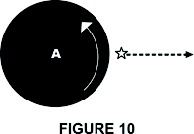
surface. This is shown in figure 10. It is a horizontal cut of core A. The star has its own inborn orbit and inborn revolving speed inherited from its core A. See figure 11.

This inherited revolving orbit and angular speed of the star (figure 11) is combined with the huge momentum and tremendous initial blast off speed of the boulder (star) – figure 10. Resultant revolving orbit (R1) of the star is shown in figure 12.

The infant star exhibits one more inherited revolving orbit. That is, the star when ejected from the core, exhibits its inherited orbit along the rotational (equatorial) path of its parent core A. This inherited orbit along the core’s equatorial rotational path is shown (as horizontal cut of the core A) in figure 13.
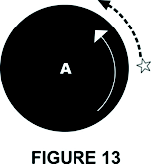
At this stage, the star has two orbital paths. One orbit is along the rotation of the core A (Fig 13).
The other orbit is the resultant R1 as shown in Fig12 and Fig14. Both these orbits and the new resultant orbit R2 are shown in figure 15.
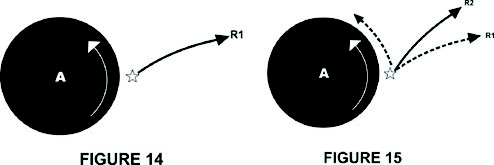
This resultant orbit R2 is much higher than R1. This R2 orbit gets further higher due to the decreasing gravitational force from core A up to the Arm of the black sphere. With this higher and higher revolving orbit, and its incredible speed, the star catches up with the Arm which graciously bends itself to receive the star. And the star successfully enters the gravity free space of the Arm. The R2 momentum of the star and its initial orbital path are however dependent on various factors – such as – the mass of the star (boulder) at its birth, the location of its birth at the equatorial surface of the core, the magnitude of the nuclear blast that launches the star, the angle of ejection from the equatorial surface etc. Hence, based on the above factors, the stars’ race to the Arm, are at various orbits, heights, speed, and momentum. The stars are therefore get sprayed at various speed, at various angles and at various places of the Arm or the Bar.
Coming up to the point, the star with its incredible speed and with the fresh resultant orbit R2 has acquired a higher revolving orbit and successfully out speeds the Arm and catches the space highway. There, the star is released from the gravitational forces of core A and core B. With the absence of the tremendous gravitational forces, the star further reaches out to much higher orbits. As long as the star is within the Arm’s breadth, it makes increasing higher orbits, to reach out to the outer circumference of the black sphere. This means that the star has now quietly enhanced its chances of going out of the black sphere, and to enter into the space.
In this connection we have to note that the bend, that is, the curve in the Arm, plays a very important role. If the Arm has no bend or curve and keeps itself as straight as in figure 7, then the infant star has to cover extra distance between the existing curve and the initial upright position of the Arm. See figure 16. The bend is a blessing.
It reduces the travelling time and distance of the star from the core to the bend in the Arm. It further plays a very brilliant solo act in discharging the star from the Arm to the space outside.
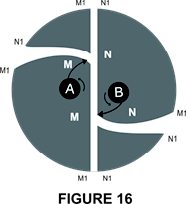
Let us watch the speedy star taking the orbital path R2, and reaching the Arm, in a series of sketches. Figure 17.1 to 17.8. The Arm and the star revolve in the same direction. The star revolves in higher and higher orbits.

Let us now consider the activities of a star that has entered the Arm. On entering the Arm, the star being freed from the tremendous gravitational pull of core A and core B, eases from its revolving orbit, and goes into higher orbits. As the gravitational force and its pull decreas-es along the star’s higher and higher orbits, the star enhances its orbital heights further and further. This is a continu-ous complimentary pro-cess.
We have now to make a detailed probe on some more facts to understand the complete activities of a star at the Arm.

Point No.1: The whole length and breadth of the Arm is not absolutely free from the gravitational forces of the cores. The breadth of any part of the Arm experiences a limited gravitational pull which is however not enough to catch and consume the light rays from the Arm. But the force is enough to enforce some gravitational pull on all materials that exist in the Arm’s area.
Point No.2: Consider the full lek side border of the Arm in the upper hemisphere. Gravitational force decreases starting from the lek border of the Arm up to the mid-section of the Arm where the gravity is nil. A star orbiting from the lek border of the Arm to the middle of the Arm experiences steep decrease in the gravitational pull from the cores and hence the star gradually and continuously increases its orbital heights. See Fig 18.1 to 18.3. Watch the orbiting star increasing its orbital heights in the Arm and reach to the outer border of the black sphere.
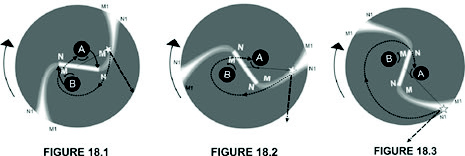
We have now come to the most important and most complicated final part of this episode. We have to approach this part with much elaboration.
Consider the case of the revolving Bar and Arm. The Bar revolves around the center of the black sphere. The angular speed of the Bar near the center of the black sphere is minimal. Now, at any height of its revolving path, the Bar or the Arm at that part, has to increase its speed, so that, that part of the Bar or the Arm at that orbital height, could be able to complete one full revolution, at the same period of time, along with any other part of the Bar or the Arm. Hence, at any given point or place in the Bar or the Arm, the angular speed at that point or place, is proportional to its distance from the center of the black sphere. That is, the angular speed of any part of the Arm increases in proportion to its distance away from the center of the black sphere.
Whereas, we had already seen that the stars are blasted out from the core with various angles and with various incredible individual speeds. Hence, any given star, irrespective of its placement anywhere, or at any orbit or at any height of the Arm, maintains its own constant incredible speed. The star needs not to keep up any appointment with that of the varying angular speed or the revolution of any part of the Arm. The star and the Arm have their own separate speedy ways. Hence, orbital positions of a star (in the Arm) will not affect its own constant incredible speed with that of the varying angular speeds of the Arm, at its different heights.
This difference between the star and the Arm, in their nature of their speed, at various heights of the Arm plays an important role in upping and pushing the star from the Arm to the space.
Let us now witness the wonderful journey of the stars starting from the inside of the Arm to the space outside the black sphere. We know that the stars with their incredible speed overtake the angular speed of the Arm and catch the Arm.
From there on, the stars enter a region of lesser and lesser gravity and hence steadily increase their orbital heights. We may now consider the sequence of activities of the stars inside the Arm that enables them to get into the space:
1. The star in the lesser gravity area of the Arm shoots out to higher orbits.
2. As the star shoots to higher orbits and rushes in its path, the Arm also revolves in its circular path. This means; as the star rushes in its orbital path, the Arm also revolves in the same direction, ever presenting and spreading out a part of its revolving space highway at the path of the star’s journey. It enables the star to continuously reach further and further heights.
3. As the star races towards the middle (no gravity area) of the Arm, the star’s orbital radius increases further and further and the orbital position gets closer and closer to the outer circum-ference of the black sphere. See figures 18.1, 18.2 & 18.3.
4. That is, the star’s posi-tion in the rotating Arm gets away and away from the center of the black sphere and gets nearer and nearer to the outer circumference of the black sphere.
5. That means, at those higher and higher positions of the star, the angular speed of the Arm at those higher positions, steadily increases.
6. The continued enhancement of the angular speed of the Arm at those increasing higher position enables that part/arc of the Arm to approach the constant speed of the star. And the Arm’s angular speed, near and above the open end of the Arm, gets greater than the constant speed of the star.
7. And the star in the Arm ever continues its upward drive without relenting its constant speed.
8. The incredible speed of the star will be of no use if the Arm does not have a bend or curve. If the Arm is as straight as in figure 7, then the open-ended part of the straight Arm with its high revolving angular speed will simply rotate away, leaving out the orbiting star at its orbital track in the Arm. The speeding – orbiting star will thus not have enough time to increase its full orbital heights and to complete its orbital race to reach the open-ended part of the Arm. However, the blessed bend of the Arm, makes a studied delay in presenting its open ended part, to the orbiting star, so that, the star gets enough flying space and time (with in the Arm) to complete its orbital race and breast the winning post of the open ended border of the Arm of the black sphere.
9. As the star races in its orbit and increases its orbital position and approaches the border, the open-ended Arm presents its open end to the orbiting star. The orbiting star contacts and crosses the border of the open-ended Arm and establishes its orbital position at the space outside the black sphere.
10. At that height, the constant speed of the star is not enough to keep up its position outside the black sphere and so the open-ended Arm rotates away from the space borne star/stars.
11. The star continues its race in its enhanced orbit in the space outside the black sphere and further increases its orbital heights due to lesser and lesser gravity in these enhanced heights.
12. As more and more stars are delivered continuously, a garland of stars—a space necklace is formed outside the black sphere. The string of stars with their individual constant speeds, maintain their ever-increasing orbital heights and display their orbital spirals inwards, pointing inwards spiraling into the black sphere and into its center – where they were born and had started their orbital journeys.
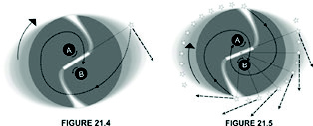
13. Stars that are blasted out; and that those of the stars having lesser speed; would take more millions of years to catch the Arm; to float in the Arm; to approach the open ended Arm; and to get to the space; than the stars that are blasted out with higher speeds which would overtake the slower elder stars; and will hence reach their destination in the Spiral Arm much earlier than their slow trailing seniors. There will therefore be old as well as young stars mixed in the Spiral Arm.
14. If at any point, the varying angular speeds at different heights of the revolving Arm could not cope up with the incredible speed of the star in the Arm, then the speedy star would cross the right-side border of the Arm and enter into the darkness of the black sphere.
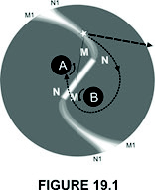
vanish into the advancing darkness from the lek side.
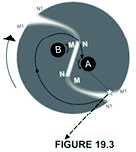
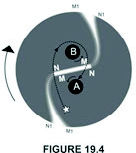
16. Thus, all the stars that are blasted out from the cores of the black sphere are not destined to enter into the space to make out the star-necklace.The black sphere with its black hole cores has thus effectively conceals its wonders in its blackness and in its total complexity. There will be much more awesome activities and wonders buried in its depth that have yet to be unraveled.
DIAGRAMS ON THE EJECTION OF STARS FROM THE ARM TO THE SPACE OUTSIDE THEBLACK SPHERE


This is only an elementary description on the galaxy formation with simple diagrams – and needs further development – certainly not be me – my limitation safely ends here – and this is a case for further studies by Astrophysicists.
As the orbits of the stars get higher and higher, the REVOLVING EX-PANDING GALAXY is born. The stars with their various angular momentums and with their varying individual speeds move in various angular directions with various speeds. In other words, the stars in the Spiral Arm speed away from each other. All the thanks go to the ARM for bending its body to receive the stars from the cores of the black sphere and nudging them to the border of the open-ended Arm and spraying them into the space. Thus, every nook and corner of the revolving Arm is perfectly functional in the formation of a galaxy. THIS IS A MOST AWE-SOME FUNCTIONAL WONDER THAT THE NATURE COULD PRIDE ITSELF. The stars now trail in the space, leaving their birthplace – the black sphere with a cheering good bye to start a new life outside its parent black sphere.
7. FULL-UNDILUTED-UNCONDITIONAL CREDIT GOES TO THE ARM – THE SPACE HIGHWAY –THE PATH OF LEASTRESISTANCE.
We have seen the activi-ties at one Arm only. The activities at the other Arm of the black sphere are an exact mirror image of the Arm one. So, both the Arms spray out continuous stream of stars on both sides of the black sphere and a spiral galaxy with two Arms is born. Further, if the two cores of the black sphere exhibit clockwise and anti clockwise rotations, then the black sphere will spray out stars in one direction only, that is, the galaxy will have only one Spiral Arm.
As the cores of the black sphere blast out the stars, huge quantity of atomic dust and gas are also released. These dust and gas clouds speed along with the stars, enter and illuminate the Arms, experience the higher and higher orbital positions in the Arms and get to the very border of the open-ended Arm. The open end of the Arm presents its open end andgives these orbiting dust clouds and the stars a passageway into the space. The dust clouds and the stars enter the space and create the Spiral Arms. These atomic dust and gas particles reflect and scatter the light rays from the nearby stars. And the trailing arms, that is, the lanes of dust get illuminated and are seen as Spiral Arms from the space.
DOI
https://doi.org/10.57259/GRJ7271
Research Objectives
All the stars in a galaxy have rotation and revolution. How do they get it? Galaxies are rather flat. Why? This research aims to understand facts of this theory on the evolution of the barred spiral galaxies.
Bio

Dr Abhishek Pandey has a MSc, Ph.D. (Educa-tion) honoris causa from Ballsbridge University, Dominica. Dr Abhishek Pandey is presently working on his dream project being founder President of Charles Walter’s Society for Innova-tion & Research managed by Charles Walter’s Council of Innovation & Research registered under the Company Act 2013, Section-8. Dr. Pandey is also appreciated by more than 100 universities across the globe and he’s more than 1000 awards from national and international benchmarks.

